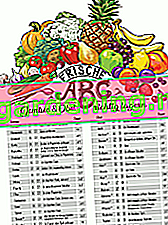
Suitable carrots
Carrots can be stored for a long time after harvest. That's why roots from the supermarket are rarely freshly harvested. But every day they spend outside of the earth gnaws at the quality. These old carrots are also not recommended for the freezer.
also read
- Hibernate carrots in the sandpit
- The right season for growing your own carrots
- Simply dry carrots from your own garden
Freeze only freshly harvested carrots from your own garden. You can also freeze leftover carrots from the grocery store, as long as they are clean and crisp. They shouldn't have any rotten spots or even mold.
Raw, blanched or cooked?
No choice is necessary here, because all three variants are possible. It's quickest raw, blanching extends the shelf life and fully cooked carrots can be thawed faster.
Choose the approach that best suits your needs. You are also welcome to use all three options if required.
Clean and prepare the carrots
Fine earth particles often adhere to carrots and should therefore always be cleaned under running water. Any green that may still be present is removed beforehand.
The next steps are peeling and chopping the carrots into smaller pieces. Neither of these is a prerequisite for successfully freezing carrots, but they do come in handy. Both of these are more difficult to achieve when frozen.
Briefly blanch the carrots
Peeled and chopped carrot pieces can survive freezing temperatures for longer if they are briefly blanched beforehand.
- Fill a large saucepan with plenty of water and bring it to the boil.
- Add a serving of carrots and cook over medium heat for about three minutes.
- Quickly cool the blanched pieces down by placing them in ice water for about two minutes.
- Drain the carrots in a colander.
Tips
For creamy carrot soups, you can cook the carrot pieces now and freeze them as puree. This saves time in later preparation.
Flash freeze and freeze
Carrots that have cooled down can be placed directly in tightly closing freezer containers and frozen or snap-frozen beforehand. With shock freezing, a thin layer of ice forms around each piece, which prevents it from clumping together later.
However, in order for this protective layer to form, the pieces must not touch each other during freezing. This works best when they are spread out on a flat tray and placed in the freezer for about two hours.
Once the carrots are frozen, they are placed in containers and stored locked inside.
durability
Blanched carrot pieces can be kept for nine months. They are frozen in boiling liquid. Unblanched pieces and puree should be used within three months.
Conclusion for quick readers
- Freshness: Freeze only freshly harvested or purchased carrots with no rotten spots or mold
- Variants: Carrots can be raw, blanched or frozen as ready-made puree
- Advantages: Raw is the fastest; Blanching extends the shelf life; Puree saves time after defrosting
- Preparation: Remove the greens and wash the carrots, then peel and cut into small pieces
- Blanching: Cook for three minutes over medium heat, then cool in ice water
- Tip: Cook the carrots and freeze them as a base for creamy carrot soups
- Shock freezing: Spread out the dried pieces of carrot on a tray and shock freeze, then place in the freezer
- Shelf life: carrot pieces can be kept for nine months; Mush is to be used within three months

The garden journal freshness-ABC
How can fruit and vegetables be stored correctly so that they stay fresh as long as possible?
The garden journal freshness ABC as a poster:
- Order here cheaply as an A3 print for your kitchen
- as a free PDF file to print out yourself







